





Academic Authors: Sneha Sharma, Anuj Gupta, Kashika Parnami, Laraine O’Connell
Creative Directors: Bhavna Tripathi, Mangal Singh Rana, Satish
Book Production: Sanjay Kumar Goel
Project Lead: Chandani Goyal
VP, Learning: Abhishek Bhatnagar
All products and brand names used in this book are trademarks, registered trademarks or trade names of their respective owners.
© Uolo EdTech Private Limited
First impression 2024
Second impression 2025
This book is sold subject to the condition that it shall not by way of trade or otherwise, be lent, resold, hired out, or otherwise circulated without the publisher’s prior written consent in any form of binding or cover other than that in which it is published and without a similar condition including this condition being imposed on the subsequent purchaser and without limiting the rights under copyright reserved above, no part of this publication may be reproduced, stored in or introduced into a retrieval system, or transmitted in any form or by any means, electronic, mechanical, photocopying, recording or otherwise, without the prior written permission of both the copyright owner and the above-mentioned publisher of this book.
Book Title: Juniors II Conversations
ISBN: 978-81-980824-4-2
Published by Uolo EdTech Private Limited
Corporate Office Address:
85, Sector 44, Gurugram, Haryana 122003
CIN: U74999DL2017PTC322986
Illustrations and images: www.shutterstock.com, www.stock.adobe.com and www.freepik.com
All suggested use of the internet should be under adult supervision.
Thanks to globalization international boundaries have become blurred. English, to a high degree, is a commonly understood medium of communication throughout the world. It is also one of the key tools that students require to perform well. According to a global study, 98.5% of employers implicitly or explicitly assess a candidate’s English communication skills while recruiting them. There is, therefore, a growing demand for English communication skills, because it empowers people and enables them to lead a better life.
Early exposure to English is essential for children’s overall academic and personal growth. It not only facilitates effective communication but also lays the foundation for all future language learning. However, it is equally imperative to adhere to a scientific approach when introducing children to English or any second language during their foundational stages.
Highlighted by a wide range of research and also by the National Education Policy (NEP) 2020, a strong foundation in listening and speaking from an early age leads to better reading-writing skills as well as improved academic performance in the target language. In fact, special emphasis is placed on conversational and communication skills at the Early Childhood Care and Education (ECCE) stage in the NEP document. Along the same lines, the first 8 years in a child’s life are deemed critical in the new National Curriculum Framework (NCF) for acquiring a language orally which forms the basis of literacy and cognitive development.
Yet, English listening and speaking often tend to take a back seat during the early years in schools against the standard teaching practices around decoding, tracing and phonemic awareness activities. In order to address this humongous learning gap during the foundational years, Uolo has launched a powerful program for oral language development in English—Uolo Speak! It comprises two worlds—the Conversations Junior book through which classroom interactions and teaching take place, and the Uolo App that houses all digital assets of the program.
Aligned with the spirit of the NEP 2020 and the NCF 2022 for foundational stages, Speak adheres to the communicative language approach, and gives precedence to developing listening and speaking skills in English in an anxiety-free, meaningful and fun-filled environment.
The program steers clear of teaching reading–writing and focuses exclusively on the oral language development of children. The book follows a theme-based learning approach where carefully curated themes become separate chapters and go on for a month. For example, ‘food’, ‘seasons’, ‘good habits’ or ‘body’ are a few of the themes that are at once crucial yet easy for learners to begin their listening and speaking practice. The focus in each theme is on giving an input-rich listening environment to children with the help of joyous stories and poems, and developing English vocabulary and oral expression around that theme in child-friendly ways. In order to develop speaking, the highly acclaimed ‘Total Physical Response’ (TPR) method is used, where repeated physical actions and gestures are used to learn words and expressions in English.
Additionally, the book is technologically powered and works in sync with a parallel digital world, which contains immersive animations of the stories and poems, for easy listening and viewing anytime, anywhere. The digital world also enables fun-filled practice of key words, phrases and sentences in English. The accompanying teacher manual guides implementation in the classroom in a step-by-step manner and makes the process of teaching–learning thoroughly enjoyable.
To sum it up, Speak is a unique blended program for developing usable English listening and speaking skills at the foundational levels in the most creative way possible. Within these colourful pages lie stories waiting to be heard, songs waiting to be sung, rhymes waiting to be danced to, language waiting to be spoken, and dreams waiting to take flight. The book not only helps children master English speaking in a joyous manner, but also transports them to far-off lands, introduces them to fascinating characters, and ignites their imagination like nothing else can. So, let your children dive into the magic of learning the English language and emerge as confident English speakers.
Welcome to the Speak journey!
The program is a thoughtfully-crafted, activities-based learning experience that build students’ speaking skills in English. The program, with dedicated time and space within the classroom, becomes a platform to practise speaking and listening skills in everyday scenarios. These scenarios are created by way of teacher-led activities, which cater to specific competencies in English.
Coursebook
Teacher Manual
Student and Teacher Apps
Talking Books
Listening and Speaking Projects
Interactive Practice Quizzes
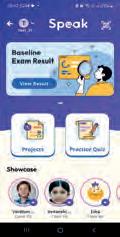
The classroom program is augmented by the digital world, which is presented to the students through the UOLO App. The app includes projects that are closely associated with the activities in the coursebook. The projects allow a fear-free practice time to children at home. The app also include quizzes in listening, speaking, reading and vocabulary building that can be consumed at home.

The National Education Policy (NEP) 2020, introduced by the Government of India, represents a transformative shift in the country’s education system. It aims to create a more holistic, dynamic and multidisciplinary approach to education. The NEP 2020 focusses on fostering conceptual understanding, skills, values and competencies that align with the demands of the 21st century, while also preserving India’s rich cultural heritage. UOLO is fully committed to actualizing the vision of the NEP 2020 by meticulously adhering to its outlined recommendations.



1. Comprehension and understanding
2. 21st century skills, values and dispositions
Competency-based Education
3. Application in real life


4. Holistic and integrated learning
5. Enjoyable and engaging

6. Technology-based solutions

7. Assessment of core concepts and application skills
NEP Pages 12, 17, 22
Teaching and Learning Pedagogy
NEP Pages 3, 11, 12, 27
Assessments
NEP Pages 12, 18, 22
Exposure to rich literature through stories and poems to provide opportunities for listening to and speaking about the texts
1 2 4 5
Vocabulary development—through the book and the digital interface—to build confidence in usage and expression
1 3 4 6 7
Enhanced listening comprehension and elevated English learning experience through animations that bring each text to life
1 5 6
Opportunities to hone listening, speaking, reading and writing skills through interactive quizzes
1 3 4 6 7
1 Comprehension and understanding
2 21st century skills, values and dispositions
3 Application in real life
4 Holistic and integrated learning
5 Enjoyable and engaging
6 Collaborative and exploratory activities
7 Technology-based solutions
8 Assessment of core concepts and application skills

Derived from global research, NEP 2020 and NCF
1. Communicative Language Teaching (CLT)
The focus is primarily on meaningful communication, effective expression of ideas and oral competence in the target language. Oral fluency and meaningful interaction takes precedence over perfect grammar and accuracy of vocabulary.
2. Theme-based Learning
One theme or topic binds all the learning content and activities, and goes on for a longer period of time. It makes the learning process more meaningful and engaging for young learners.
3. Total Physical Response (TPR)
This method of language teaching is exceptionally valuable for young learners when they are learning a new or second language. In this method, children use their bodies and movements to respond to language instructions given by the teacher. This tactile and interactive approach makes second-language learning lots of fun as children connect words with actions, helping them remember and use the language more effectively.
4. Holistic and Integrated Education
English learning is organically integrated with concepts of health, culture, science, environment, current affairs, socio-emotional learning and sports.
5. Supportive Environment for Second Language Acquisition
In order to master oral fluency in English language, an anxiety-free and input-rich environment is created with the help of rich texts, fun activities and digital platforms.
6. 21st Century Skills
21st century skills like confident expression, critical thinking, problem solving and digital literacy are addressed through interactive activities and engaging content.
The National Curriculum Framework for Foundational Stage (NCF) , released in 2022, is developed based on the vision of the National Education Policy (NEP) 2020, and to enable its implementation. The NCF provides guidelines for designing school syllabi and textbooks in India. It aims to improve the quality of education by making it more relevant, engaging, inclusive, and learner-centric. To achieve this, the NCF has articulated precise Learning Standards through well-defined Curricular Goals and Competency statements. These statements serve to harmonise the syllabus, content, pedagogical practices, and assessment culture, ensuring a cohesive and comprehensive educational experience. Curricular Goals: Curricular Goals are statements that give direction to curriculum development and implementation. They are derived from Aims and are specific to a Stage in education.
Competencies: Competencies are learning achievements that are observable and can be assessed systematically. These Competencies are derived from the Curricular Goals and are expected to be attained by the end of a Stage.













C-1.1 Shows a liking for and understanding of nutritious food and does not waste food
CG-1 Develops habits that keep them healthy and safe
C-1.2 Practises basic self-care and hygiene
C-1.3 Keeps school/classroom hygienic and organised
C-1.4 Practises safe use of material and simple tools

C-1.5 Shows awareness of safety in movements (e.g., walking, running, cycling) and acts appropriately
C-3.1 Shows coordination between sensorial perceptions and body movements in various activities
CG-3 Develops a fit and flexible body







C-3.2 Shows balance, coordination, and flexibility in various physical activities
C-3.3 Shows precision and control in working with hands and fingers
C-3.4 Shows strength and endurance in carrying, walking, and running















C-4.1 Starts recognising ‘self’ as an individual belonging to a family and community
C-4.6 Shows kindness and helpfulness to others (including animals, plants) when they are in need
CG-4 Develops emotional intelligence, i.e., the ability to understand and manage their own emotions, and responds positively to social norms















































C-4.7 Understands and responds positively to different thoughts, preferences, and emotional needs of other children
C-5.1 Engages in age-appropriate work at school and/or at home
CG-5 Develops a positive attitude towards productive work and service or ‘Seva’
C-6.1 Shows care for and joy in engaging with all life forms
CG-6 Develops a positive regard for the natural environment around them
C-7.1 Observes and understands different categories of objects and the relationships between them
CG-7 Makes sense of the world around through observation and logical thinking
C-7.2 Observes and understands cause and effect relationships in nature by forming simple hypotheses and uses observations to explain their hypotheses
C-7.3 Uses appropriate tools and technology in daily life situations and for learning
C-9.1 Listens to and appreciates simple songs, rhymes, and poems
C-9.2 Creates simple songs and poems on their own
CG-9 Develops effective communication skills for day-to-day interactions in two languages
C-9.3 Converses fluently and can hold a meaningful conversation
C-9.4 Understands oral instructions for a complex task and gives clear oral instructions for the same to others
C-9.5 Comprehends narrated/read-out stories and identifies characters, storyline, and what the author wants to say
C-9.7 Knows and uses enough words to carry out day-to-day interactions effectively and can guess the meaning of new words by using existing vocabulary
C-11.1 Develops phonological awareness and is able to blend phonemes/syllables into words and segment words into phonemes/syllables
CG-11 Begins to read and write in Language 2
Dear parents,
We’re thrilled to introduce the Speak program, which is all about nurturing your child’s listening and speaking skills in English. It comprises two worlds—the Conversations book through which classroom interaction and teaching take place, and the Uolo App that houses all digital assets of the program.
The book is packed with colourful illustrations, exciting stories and poems, and powered by QR codes for a seamless transit into the digital world. The listening and speaking activities are entirely research-based and adhere to the guidelines of the NEP 2020 and NCF. The book, if followed in its true spirit, is a journey filled with laughter and learning. Through these engaging texts and nurturing experiences, your child is immersed in a world of English language which is not only fear-free but also super fun.
Therefore, we invite you to actively participate in this learning adventure with your children. Reading aloud to your child, practising together, and encouraging conversations are all wonderful ways to support their language growth. The following are a few simple tips that would help you support your child better:
• Do not force your child to read or decode the words and sentences written in the book. The whole range of text is exclusively curated for listening and speaking in English.
• Use the home language for support wherever needed to explain the meaning of the texts or during conversations.
• Discuss the visuals on the cover page with your child and talk about the theme.
• Read the stories given in the book aloud to your child with lots of expression and action. Talk about the illustrations too. Know their thoughts and feelings about the key events in the story. Scan the QR code to play the animation of the story on the Uolo app.
• Sing the poems to your child with lots of action. Encourage your child to repeat the poem with actions and help them memorise it. Talk about the illustrations and scan the QR code to play the animation of the poems on the mobile app.
• Ask your child to share some of the words and sentences they learnt to speak in the class on a regular basis. Help them practise saying these with fluency and confidence. You can add a few words and sentences on your own too.
In the end, we would like to thank you for entrusting us with your child’s early education and language development. Let us work together to build a strong foundation for your child in English listening and speaking which will go on to serve them well throughout their lives. If you have any questions, thoughts, or ideas to share, please don’t hesitate to reach out. We’re here to make this journey as enjoyable and rewarding as possible.



Title Page: It depicts the serial number and the theme of the chapter.
2

Story Time: A fun-filled story, with stunning visuals, that highlights key words and phrases related to the theme. QR codes enable easy access to the animation of the story on the mobile app.



I
Breakfast on the plate!
Yummy! Milk and bread.
Speak Express: All the key words and phrases that are covered in the three texts have been placed together so that children can practise English usage in their daily lives. QR codes enable easy access to correct pronunciation.
1 3 5
I will watch a cartoon show.
I will play with clay.
To the garden, I will go, And enjoy all day.
When I come back home, I will eat and rest.
I will bathe in foam,



Rhyme Time: Two sing-song poems, set against striking and vivid visuals, that highlight key words and phrases related to the theme. QR codes enable easy access to the animation of the poems on the mobile app. Brain Booster: hone children’s cognitive and fine motor skills.
Story time Good morning! I am Kunal. I want to tell you about my I wake up early in the morning. Then, I brush my teeth clean. After that, I take a bath and get ready for school.
Before going to school, I eat my breakfast. Yummy! I feel At school, I play with my friends. I also learn to read and I draw and colour too.



What is your daily routine? Number the pictures 1 to 6 in the right order.




My Routine
My Daily Routine
Fruits and Vegetables
The Kitchen Garden
Modes of Transport
Ragini’s Trip to the Village
People Around Us
Mehek’s Stomach Ache
Games Time
Golu Learns to Cycle
The Beautiful Sky
Chutki Ate the Sun
Wonderful Nature
Rani Cleans the Park




Good morning! I am Kunal. I want to tell you about my day.
I wake up early in the morning. Then, I brush my teeth to keep them clean. After that, I take a bath and get ready for school.
Before going to school, I eat my breakfast. Yummy! I feel so strong.
At school, I play with my friends. I also learn to read and write. I draw and colour too.


Then, I come back home. I eat lunch and I sleep. When I wake up, I drink some milk. I listen to funny rhymes.
In the evening, I go to play with my friends. After that, I come home and clean myself up. Then, my mother and I read stories together from colourful books.
At night, I eat dinner with my family. We share stories and jokes. After dinner, I brush my teeth. I say “Goodnight!” to everyone and go to sleep.
The next day, I follow the same routine.


Today is Sunday!
What a fun day!
Yippee! Hoorray!
It is a holiday!
I will wake up late, And eat on the bed. Breakfast on the plate!
Yummy! Milk and bread.
I will watch a cartoon show. I will play with clay.
To the garden, I will go, And enjoy all day.
When I come back home, I will eat and rest. I will bathe in foam, Sundays are the best.



In Richa’s room, Night and day,
The Talking Clock talks. But what does she say?
“Good morning, Richa!
It’s breakfast time.” Says the Talking Clock, In a musical rhyme.
“Good afternoon, Richa! Here is your plate. The lunch is ready, It will not wait!”
“Good evening, Richa! Get ready for dinner. It’s night time, One should sleep sooner.”

wake up I wake up early.
brush I brush my teeth.
take a bath I take a bath every day.


eat I eat food.
learn I learn to paint.
drink I drink milk.




play I play in the park.
sleep I sleep at night.
breakfast I eat breakfast in the morning.


watch I watch TV.
lunch I eat lunch in the afternoon.
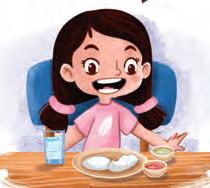
dinner I eat dinner at night.


What is your daily routine? Number the pictures 1 to 6 in the right order.




Gappu is sad. He does not like his new house.
Gappu misses his old house. He thinks about his big garden. He misses watering the tomato and lemon plants.
Gappu is in his room. He hears his father call him.
“Gapppuuuuuuuu! Please come here.”


“SURPRISE!” His mother, father and grandmother shout in joy!
He sees a beautiful garden! There are so many plants—curry and mint, chillies and brinjal, carrots and spinach.
“This is your new kitchen garden, Gappu. You can help grow many vegetables here”, said his grandmother. Gappu is happy.

In a fruity land, where all fruits grow, The fruits put on a funny show.


Apples tell jokes, bananas wear hats, Grapes are busy with their chats.


Oranges and guavas dance on a beat, Pineapples party all over the street.
Watermelons and mangoes race so fast, In the fruity land, we all have a blast!



Let’s all sing The Vegetable Song, Veggies are both short and long!
Spinach is green,
Eat your veggies clean.


Ginger-garlic add flavours bold, I like potatoes, hot or cold.
Cucumber and corn make a salad wow! Green leafy vegetables—eat them now.
When Dad chops onions, he always cries,
But in hot oil, they are tasty fries.
From the earth, they brightly spring, Veggies, veggies, let’s all sing!



tomatoes Tomatoes are red.
lemons Lemons are yellow.
carrots Carrots are orange.
spinach Spinach is a green vegetable.


apples Apples are sweet.
bananas Bananas are healthy.




grapes Grapes are tasty.
oranges Oranges are round.
mangoes I like mangoes.
potatoes Potatoes are brown.
cucumber I eat cucumber.
onions Onions make me cry.

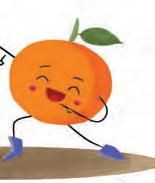





Colour what you see.




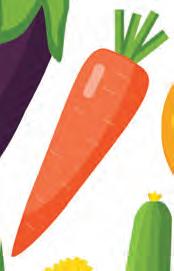












This summer vacation, Ragini is going to her village. She is very happy.
She asks her father, “How will we go to the village?”
He says, “Our village is very far. First, we will go to the airport. From there, we will take an aeroplane to Ranchi.”
“Wow,” says Ragini, “we will fly high in the sky!”
“Yes, Ragini dear“ says father. “From the airport, we will take a taxi, and go to the train station” says father.

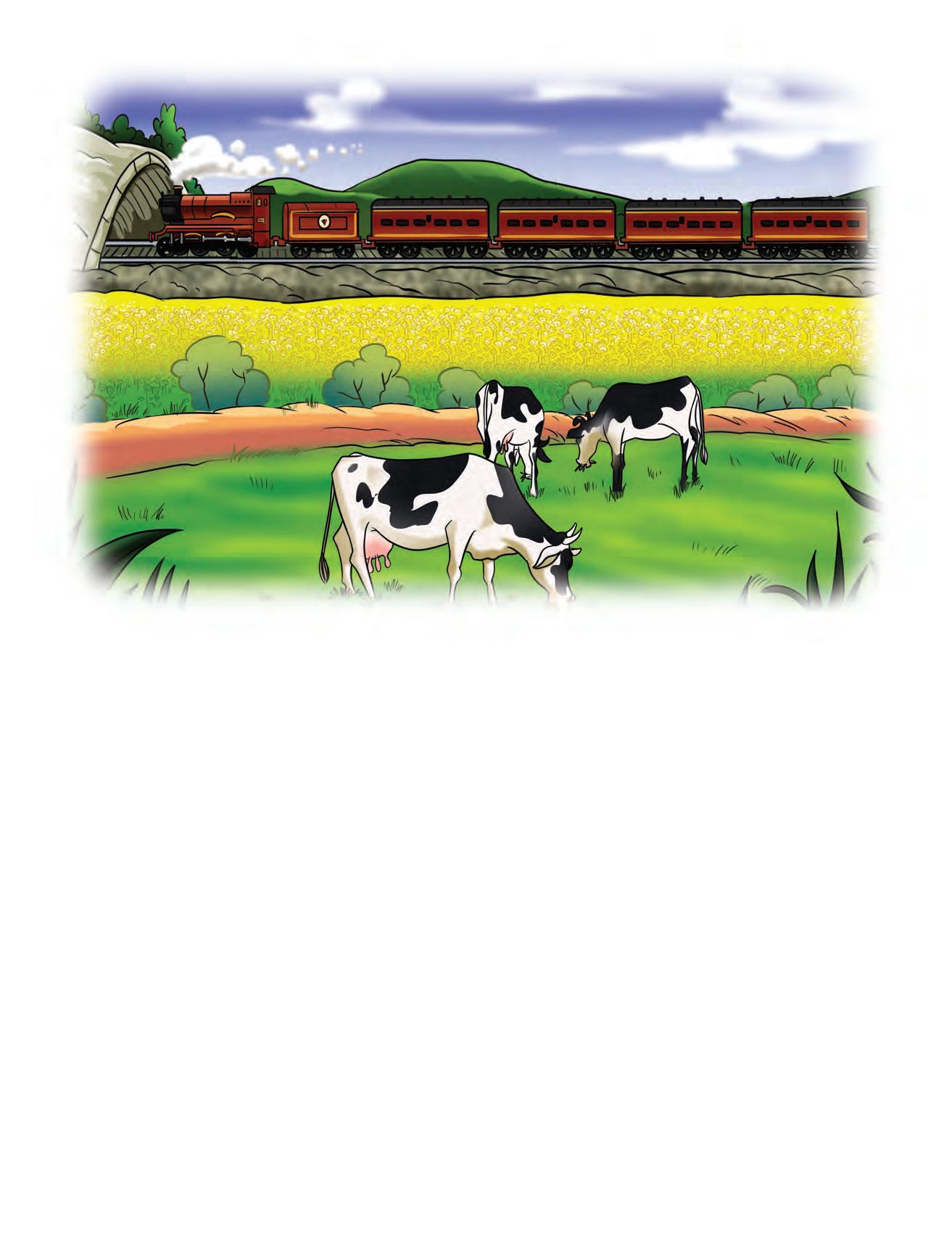
“We will sit in the train too? Koooooooooo… chuk chuk chuk chuk chuk chuk…”
“Hahaha! Yes! You will see farms and cows on the way. After reaching the village, we will take a cycle rickshaw to reach your grandfather’s house.”
“This is going to be the best trip ever!”


How do I go
To the museum so far?
Scooter, auto rickshaw
Or travel by car.
How do I go
To buy fruity cakes?
I ride a bicycle
To the shop that bakes.
How do I go
To the school every day? In the school van
Or rickshaw, if I may.
How do I go
To the pet shop?
Take the big bus
And pay at the stop.



I am big with wings.
I fly very high.
I am an aeroplane!
I roam in the sky.
Blades go round and round, Up above the ground. I am a helicopter! I take you around.
I am found in rivers.
On water, I float. My body is of wood.
I am a little boat!
Over seas and oceans, If you take a trip, You sail on me.
Hi, I am a ship!

aeroplanes The aeroplanes fly in the sky.

taxi A taxi has four wheels.
train Trains are very long.

cycle rickshaw Cycle rickshaw has three wheels.
bicycle I have a red bicycle.
scooter I ride on the scooter.



auto rickshaw I sit in an auto rickshaw.

car I have a blue car.
van I go to school in a van.
bus I go to the zoo in a bus.


boat Boat is used on rivers.
ship The ship is very big.



Match and colour.




Mehek has stomach pain. Her mother says, “Let us go to the doctor, Mehek.”
“Nooooooo!!!! The doctor will give me an injection.’’ cries Mehek loudly.
“No, Mehek! The doctor will help you feel better,’’ her mother says kindly.
“How? Doctors don’t tell us stories and poems like teachers,’’ says Mehek.
“Yes, dear! But they are kind and caring. They give us medicines when we are sick.”



The driver drops them at the doctor’s clinic.
The doctor checks Mehek’s stomach. “Does it pain here?” asks the doctor.
“Ahhhhhh” says Mehek, in pain. He gives her a medicine. Mehek feels good now.
Mehek and her mother are going back home. They buy some fruit from the shopkeeper for Mehek.
Mehek will eat fruits to stay healthy and fit.

Our helpers are our friends. On them, everything depends.
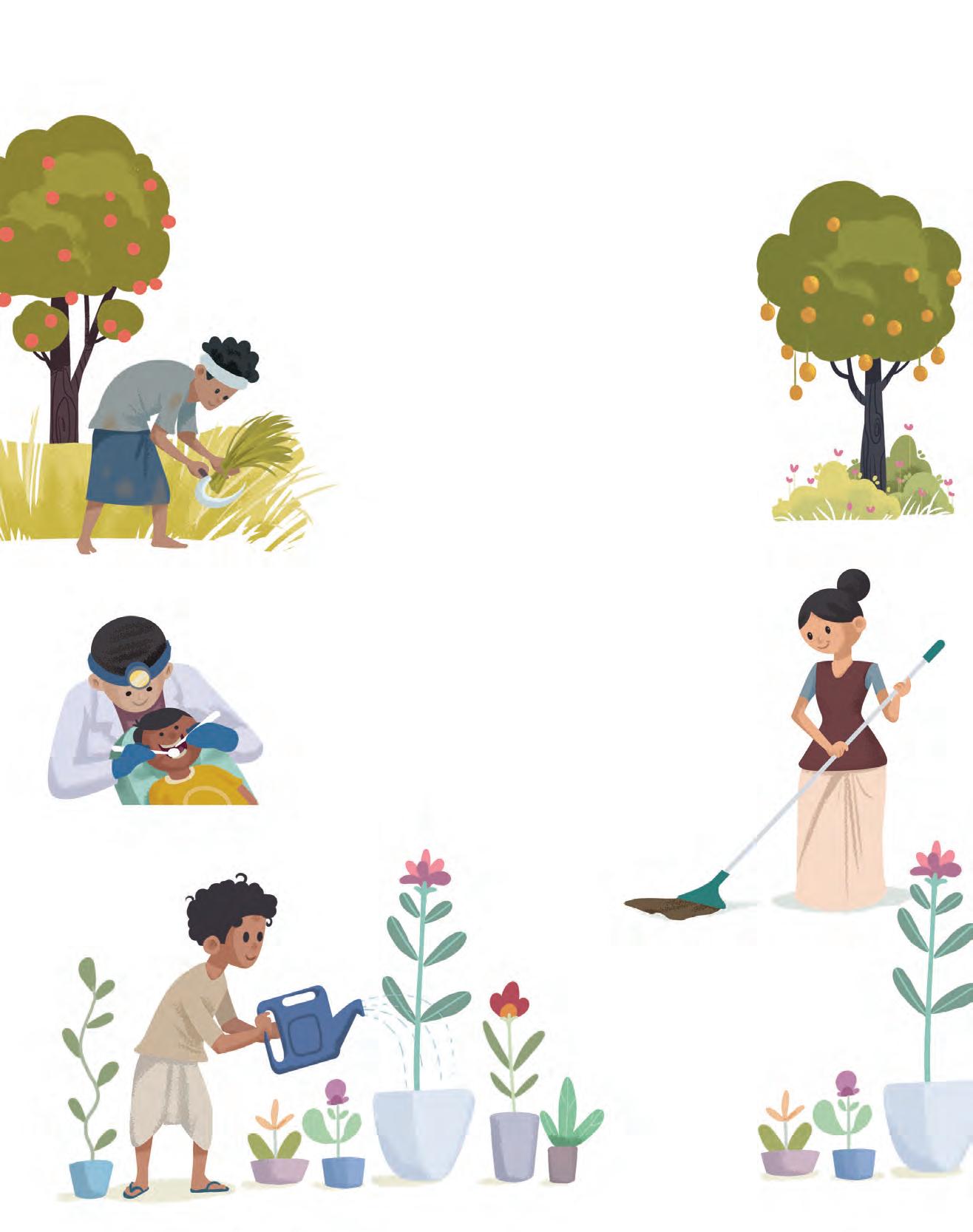
The farmer grows the food. For all seasons and mood.
The sweeper cleans the school. All the classrooms and the pool.
The dentist is dressed in white. He makes our teeth clean and bright.
The gardener grows plants and flowers. He works hard for so many hours.



People around us, big and small, Work day and night to help us all.
The brave watchman keeps us safe, The baker bakes us yummy cakes.
The painter paints apples and pears, The carpenter makes tables and chairs,
The doctor asks us to eat fruits, The tailor stitches our pants and suits.
People around us, big and small Work every day to help us all.

doctor The doctor gives us medicines.

teacher My teacher reads poems.

driver The driver drives a car.
shopkeeper The shopkeeper sells toys.
farmer The farmer grows food.
sweeper The sweeper cleans the school.



dentist I go to the dentist.
gardener The gardener waters the plants.


watchman The watchman keeps us safe.

baker The baker bakes cakes.

painter The painter paints flowers.

tailor The tailor makes our dress.


Match the helpers with their tools. Colour the pictures.






Golu wants to ride his new bicycle. It is a little red bicycle with a basket.
Golu wakes up early in the morning. He goes to the park with his elder sister Ginni. There are many other children in the park. Some are playing with a bat and a ball. Others are having fun on the swings. A few kids are flying kites. Some are playing football.
Golu wants to ride his bicycle but he is scared.


Golu tells his sister, “Please help me. I want to learn to ride the bicycle.”
Ginni says, “Sure, Golu! I will hold the bicycle from the back.”

Golu wears his helmet and hops onto the bicycle. Ginni holds the bicycle for some time. Then, she leaves the cycle. Golu starts to ride on his own.
“Yoohoooooo, I did it!”, shouts Golu.
“Tring-tring! Tring-tring!”, Golu rings the bell!


Let us play, both in and out
We are happy, let us shout.
Kick a ball, run so fast
Let us all have a blast.
It’s ludo time, roll a dice,
Playing with friends, is so nice.
Run and hide, in a secret place
Find your friend, with a happy face.
On your mark, get set go
Let us race, to and fro.
Hold the bat, swing and hit
It is fun, to play cricket.



Hip-hip hurray,
Cheer and play, Laugh and share, Play every day.
Three, two, one Bounce the ball, All of us play, Big or small.
Hop and skip, And kick and run
Jump up high, To reach the sun. Let us play, You and I.
Win or lose, Never cry!

bicycle My bicycle is red.
bat I have a bat.
ball I bounce the ball.
kite I fly a kite.
football I have a big football.
ludo I like to play ludo.







race I run in the race.
kick I kick the football.
run I run very fast.
jump I jump very high.
win I play to win.
lose I lose some games.






Match the following. Circle the game that you like the most.































































Chutki is a baby elephant. Every day, she goes with her mother to the park. Today, it is too hot! Mother Elephant is thirsty. Chutki wants to help her.
Chutki puts lots of tables on top of each other. She climbs and reaches high in the sky. There is the sun—big, round and orange! She opens her mouth and eats it.
Everything is dark. There is no light. It looks like the night.

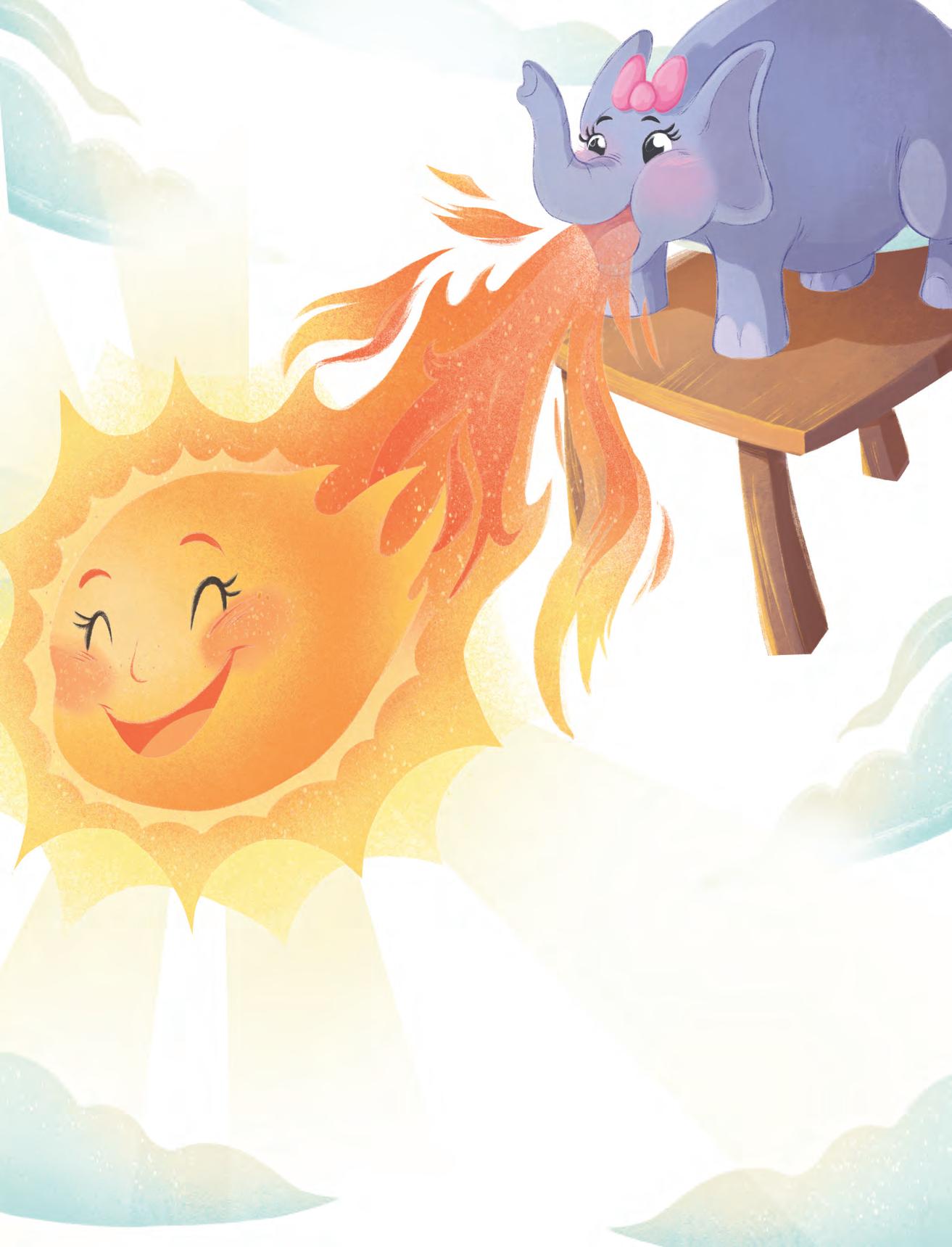
Chutki’s stomach is so big now! She runs to her mother and tells her everything.
“My dear Chutki! The sun gives us light. It keeps us warm. Let us send the sun back to the sky,” says Mother to Chutki.
Chutki climbs the tables again and reaches the sky. She burps out the sun. “Buh-uuuurrrp!” Hurray! The sun is back in the sky.

Pretty moon, pretty moon, So bright and round! You shine on my house. You shine all around.
Pretty moon, pretty moon, Sometimes you are small. Some nights you are big, Like a silver ball!

Pretty moon, pretty moon, You always smile and glow. Sometimes you go hide, Sometimes say, “Hello!”



Twinkle, twinkle,
A tiny little star. Up in the sky, You live very far. So many of you, Big and small. I make a wish, When you fall. You glow and shine Every night.
I come to meet you, Flying on a kite.

sky The sky is blue.
sun The sun is hot.
dark The night is dark.
night I sleep at night.
moon The moon is beautiful.
bright The day is bright.











shines The sun shines.
glow The moon glows in the sky.

twinkle The stars twinkle.
tiny The stars look tiny.
stars We see stars at night.
far The clouds are far.


















Colour the things that you see in the sky.





Rani goes to the park with her mother and aunt.
Oh no! The park has a lot of garbage. There are lots of plastic bags, old bottles and empty packets. The dustbins are broken.
“Eww, aunty! Why is this park so dirty?” asks Rani. She covers her nose with a hanky.
“No one cleans the park here.” says Rani’s mother.
“Can we clean this on our own?” Rani asks.
“Yes! Let’s do it on Sunday. I will ask my friends for help.” says Rani’s aunt.

On Sunday, Rani and the others wear their gloves and masks. They bring new dustbins too.
They pick up all the garbage and throw it in the dustbin. They also water the plants and trees.


In one week, the park looks different! Children go there to play every day. It has soft green grass. It also has lots of trees and flowers. The bees and butterflies dance around. The park is beautiful and clean.

I am a river, I flow, flow, flow. Let me tell you stories Of the places I go.

I see the mountains, So high, high, high. Green, brown or white, They touch the sky.
I see the lakes, So blue, blue, blue. They shine like a mirror, You can see you!
I see the forest, With trees tall, tall. Big wild animals, And streams that fall.


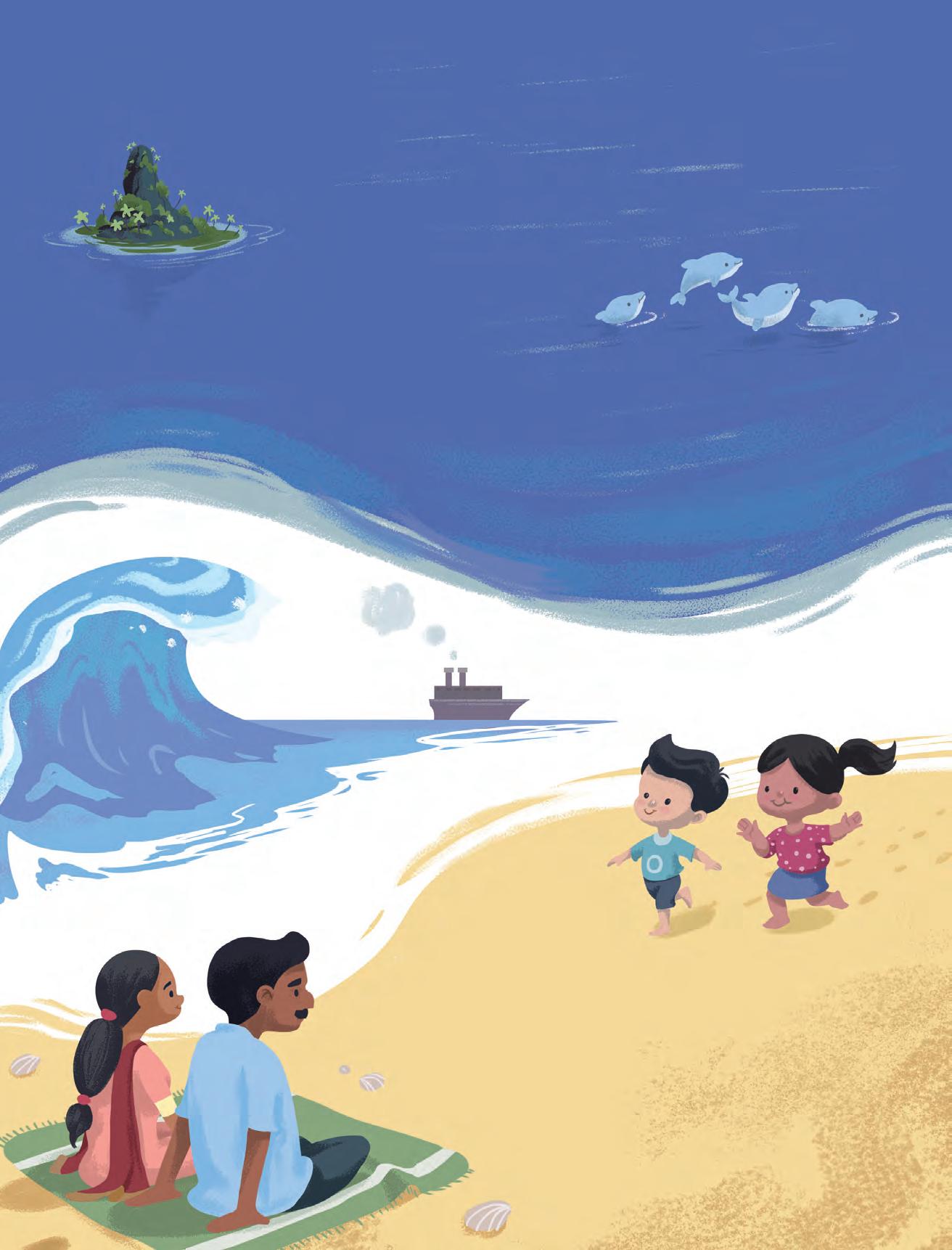
The big and deep, Dark blue sea!
Roars and dances, For all to see.
Waves big and high, Splash on my face! Water far and wide, No land in place!
Dolphins and whales Swim in the sea.
See that island? And the coconut tree?
Build a castle, Tall and grand, On the beach, With golden sand!

park I play in the park.
plants I like to grow plants.
trees Trees give us food.
grass
The grass is soft.
flowers The flowers are colourful.

river The river flows.


mountains The mountains are very big.

lake The lake is clean.
forest The forest has many trees.
sea The sea is deep.
waves The waves are high.
beach I sit on the beach.




Colour this picture.




In a magical land, there lives a big, brown horse, Heera. He loves all the seasons!
In the spring season, flowers look bright and colourful. The butterflies dance all around. Heera runs after them.
Then, the summer season comes. The sun shines bright in the sky. Heera wears his hat and a pair of sunglasses. He sips coconut water and bathes in the streams.


Soon after, big drops of rain fall from the cloudy sky. The rainy season is here! The leaves turn green.
Heera wears his raincoat and opens his umbrella. He plays in the rain.
At last, the winter season comes. The air gets chilly. The mountains are covered with white snow!
Heera wears his warmest coat and a woollen cap. He builds a snowman and drinks hot milk.

Summer days are warm and bright, We play outside, day and night.
Cotton clothes we wear in the sun, Go for a swim! Wow, so much fun!

Winter chills us night and day,
In the blanket, we sleep away!
Scarves woollen, and gloves so thick, Wear them now, or you’ll fall sick.


Rain, rain, falling down
See these puddles all around!
Pitter-patter, drip-drop-drip
See the rain hit the ground!
It gets wet on a rainy day
Out in the rain, let us play!
Wear a raincoat, float a boat,
Rain is fun, what do you say?
Drops of rain, fall from the sky
Let us dance—both you and I.
Jump in puddles, sing rain songs,
Under the umbrella, we are dry.


seasons All seasons are beautiful.

spring The flowers grow in spring.

summer Summers are hot.
rainy I like the rainy season.
winter Winter is cold.



warm The sweater is warm.

cotton Cotton clothes are soft.
blanket The blanket keeps me warm.
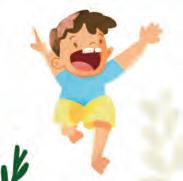

woollen I wear a woollen cap.
wet I get wet in the rain.
raincoat I have a yellow raincoat.


umbrella I have a red umbrella.


Colour the picture that shows the season.














The summer holidays are over. All the students are happy to come back to school. They went to different parts of India for their vacation. They talk about it in the class.
“I went to Jammu and Kashmir. The mountains there were so big! They were covered with white snow! The Dal Lake was blue and beautiful!” says Asif happily.
Tina says, “I went to Jaisalmer. The desert was so hot. I enjoyed riding on the camel. I also ate dal-bati-churma!”


“I went to Kerala with my family. I saw the sea for the first time! The beaches were so much fun,” says Joseph.
“My turn! I went to Assam,” says Manju. “My grandparents live there. We went to a national park. It had lots of rhinos.”
“Our country has everything—mountains, deserts, seas, beaches and forests! Next time, I will go to a new place,” says Asif.


Look at the Lotus, Pink and bright. Our national flower, Is a lovely sight!
Look at the Mango, Have a slice. Our national fruit, Tastes so nice.
Look at the Tiger, With stripes so bold. Our national animal, Is orange and gold.
Look at the Peacock! Its dance, so grand. Our national bird, Most beautiful on the land.



Look at India’s flag, What a view, Let’s sing about it, Me and you.
Our national flag, Flies so high. It is of tricolour. Do you know why? It has three colours, Saffron, white and green. Also a blue wheel, Which is in between. Our flag stands So big and tall, We salute it! It’s loved by all.

India I live in India.
mountains The mountains are very big.

desert A desert is very hot.

sea Ships move in the sea.
beaches I like to sit on beaches.





country I love my country.


forests The forests have many trees.
lotus Lotus is pink.
mango I like to eat mango.
tiger The tiger roars.
peacock The peacock dances in the rain.




flag I love the Indian flag.


Colour the national symbols of India.

The Conversations book is a vibrant educational resource tailored for young learners whose native language is not English. Comprising engaging stories and charming poems, this book offers a joyful way to build age-appropriate English listening skills, common vocabulary, and everyday expressions in the language. The activities are teacher-led and are based on the acclaimed ‘Total Physical Response’ (TPR) approach, enabling young learners to practise English speaking and listening skills in a manner that is fun and interactive.
• Activity-based Learning: The book offers joyful and experiential activities that build English communication competencies.
• Texts as per NEP 2020 Themes: The book has exciting and stimulating texts that pave the way for English communication activities.
• Teachers’ Manual: The book is complemented by the Teachers’ Manual that enables teachers to conduct each session effectively.
Uolo partners with K-12 schools to provide technology-based learning programs. We believe pedagogy and technology must come together to deliver scalable learning experiences that generate measurable outcomes. Uolo is trusted by over 15,000+ schools across India, South East Asia and the Middle East.
ISBN 978-81-980824-4-2
